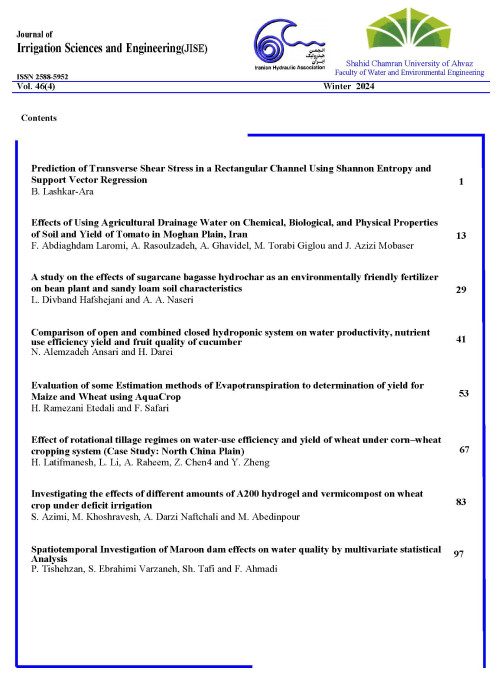The effect of the vortex caused by obstacles and its reduction, on the dimensions of the flow separation area at the beginning of the lateral intake
Vortex shedding behind the obstacles is one of the factors affecting the transfer of sediments to the downstream of the structures. The flow entering the intake has a lot of momentum in the direction of the main channel, and because of this, flow separation occurs inside the intake. This area reduces the effective cross section of the flow at the beginning of the intake. On the other hand, increasing the flow pressure of the downstream mouth of the intake, the complex flow pattern in the mouth of the intake causes changes in the alluvial bed of the open channels. Haghbin and Ghomeshi (2014) by investigating the effect of the vortex caused by the cylindrical obstacles located in the intake with diameters of 24 and 34 mm and with two discharge ratios (the ratio of flow rate per unit width of the intake to flow rate per unit width of the main channel) 0.63 and 0.83 for flow rate of 21.17 liters per second and two intake ratios of 0.43 and 1.07 for the flow rate of 17.82 liters per second, they reached these results that in the case of using obstacles with a larger diameter, the amount of bed sediments entering the water intake, in comparison it is less by using obstacles with a smaller diameter. Also, the amount of sediment entering the intake in the case of a smaller intake is less than that of a larger intake. In another paper, Khanarmuei et al (2016) discussed the effect of vortex formation on sediment transport in two-pipe intake. The intended research was investigated using a scaled physical model. Experiments were performed on the inlets of two pipes in three common inlet directions (vertical, horizontal, and at an angle of 45 degrees). In each experiment, the category of the vortex was determined according to its strength. Particle tracking velocity (PTV) was used to measure the tangential velocity of vortices. The results showed that the speed of sediment transport is significantly affected by the strength of the formed eddies. With the increase in the strength of the eddies, the rate of transfer sedimentation increased. Also, the amount of sediment transfer was affected by the inlet angle of the pipe. It can be concluded that the minimum and maximum sediment transfer rates occur for inclined and horizontal intakes, respectively. In the past researches, understanding the pattern of sedimentation in the entrance and inside the intake, in the presence of obstacles and vortex formation, has received less attention. In this research, by using cubic obstacles in the case of the flow hitting the top of the obstacles, which has a greater vortex strength after the obstacles compared to the case of hitting the side, an attempt was made to investigate the effect of the vortex on the dimensions of the separation area at the beginning of the intake according to the sediment pattern.
Intake , Separation , Sediment , Cubic Obstacles , Vortex
- حق عضویت دریافتی صرف حمایت از نشریات عضو و نگهداری، تکمیل و توسعه مگیران میشود.
- پرداخت حق اشتراک و دانلود مقالات اجازه بازنشر آن در سایر رسانههای چاپی و دیجیتال را به کاربر نمیدهد.



